
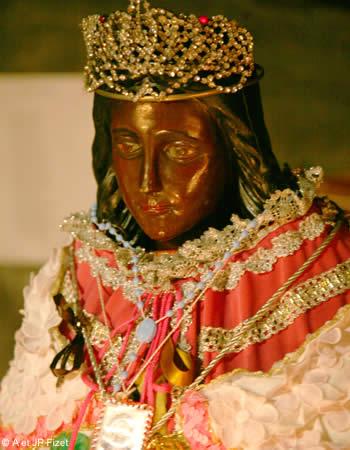
The Church of Les Saintes Maries de la Mer experiences a few times a year hours of intense fervor that accompany these Pilgrimages. Romanies, Manouches, Tziganes and Gitans come from the four corners of Europe and even other continents to venerate their Saint, the Black Sara. They camp on the streets, on the squares, on the beach. During eight to ten days, they are at home. The pilgrimage is also the occasion for reunions of friends and family, and most of the children are baptized in the Church of the Saints.
- May 24 and 25 (Sara's Procession to the sea, the 24th Procession of the Saints Mary Jacobe and Mary Salome, the 25th).
- On the Sunday closest to October 22 (Procession of the Saints Mary Jacobe and Mary Salome).
These festivals go back to the Middle Ages and their ceremonies are still the same; the crowd, candles in hand, sing and praise the Saint Marys.
May 24
A procession takes Sara, the Patron saint of the Gypsies to the sea. Just before this, inside the Church, the reliquaries contining her relics have been slowly brought down from the "High Chapel" by means of a winch, in the midst of the songs and praises. The statue of Sara, carried by the Gypsies to the sea, symbolizes the waiting forand welcome of the Saints Mary Jacobe and Mary Salome.
This day's procession, in honour of Sara and the Gypsies, is a recent institution. In 1935, the Marquis de Baroncelli and a few Camargue Gardians, anxious to give the Gypsies in the Pilgrimage a place that they didn't have (at this time, there were just a few hundred of them, lost in the bigger crowd of pilgrims from Provence and the Languedoc), suceeded in organizing with the Gypsies of the region this march to the sea in memory of the arrival of "their Saint".
May 25
Following the morning's solemn mass, the "craft", with the statues of the Two Marys aboard, is borne to the sea, accompanied by the crowd of gypsy and non-gypsy pilgrims, carried by the ranchers on horseback and the Arlésienne girls in costume. The bearers go into the sea to well symbolize the arrival of the Saints Mary Jacobe and Mary Salome and of the Faith. The Bishop, on board one of the traditional fishers' boats, blesses the sea, the region, the pilgrims and the Gypsies. The Procession then returns to the Church amidst the joy and acclamations, accompagnied by musical instruments and the set of bells. In the afternoon at the Church, with prayers and a popular fervor, the ceremony of bringing the reliquaries back up to the "High Chapel" takes place.
During these two days, services and vigils follow one another in the Church.
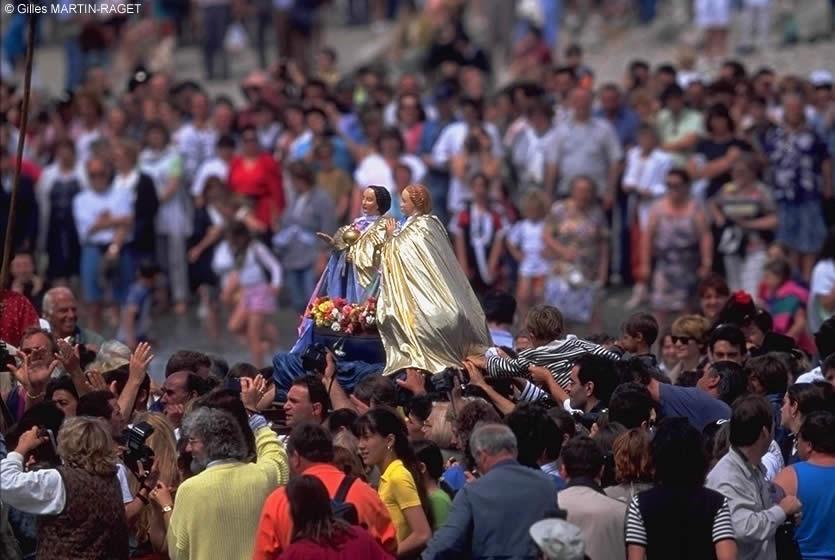
The Gypsy's Pilgrimage - Les Saintes Maries de la Mer
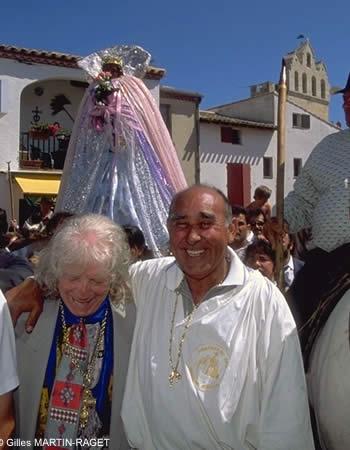
Eight or ten thousand Travellers occupy the Camargue town. Note that their caravans are not just parked anywhere and anyhow. This ephemeral town has its avenues and alleyways, and also its neighbourhoods in which all the residents seem to be like a family. It's because the Gypsy peoples are not just one people but many. Let's get to know them.
The Gitans
If the name "Gitan" is given in France to all of the populations of gypsy origin, it legitimately only belongs to one sole group, by far the most numerous and the most established in Saintes Maries de la Mer. Spain had been for a long time their favoured country: their family names have kept reminders of it, just like their dialect: the "kâlo",, unfortunately dying out... The women are very dark haired, the men have dark skin. They call themselves either "Catalans", or "Andalusian", according to their principal place of settlement. They number dozens of thousands in the South of France, where some have definitively settled since many years ago, even several generations. But there are also Gitan shanty towns whose population has increasd tenfold with the arrival of Gypsies from North Africa.
It was the Gitans who gave Spain the best of Flamenco, and also the famous dancers (Luisillo, Imperio Argentina, Carmen Amaya, Lola Florès and La Chunga), as well as generations of great toreros. And to France, an inspired guitarist: Manitas de Plata.
The Roms
These are the most easily recognizable, as the women continue to wear the traditional multicoloured skirts that fall all the way to their feet, and, when married, a scarf tied around their heads. The richest sport necklaces of gold coins, which make up the tribe's treasure. Many say life is an adventure, while the men are tinkers, coppersmiths or gilders. These professions prompt them to reside in industrial suburbs, notably in Paris, Lyon and Lille. This is the group that has most jealously preserved its original aspects: the language (close to Sanskrit), the traditions, the legends. After crossing Central Europe, the Roms are today spread out around the world, from Canada to Australia South Africa.
The Manouches
The Manouches (and their cousins, the Sinti), scarcely distinguish themselves. The poorest are basket makers, and have kept their horse-drawn caravans; others are fairground sellers or iron gatherers. The Manouches stayed for a long time in Germany and bear Germanic names (ex: Django Rheinardt); the Sinti have retained the mark of their passage in the Piedmont (ex: the circus family Bouglione). Both have a veritable passion for music, and it is from amongst them that the famous tzigane orchestras recrute their virtuosos.
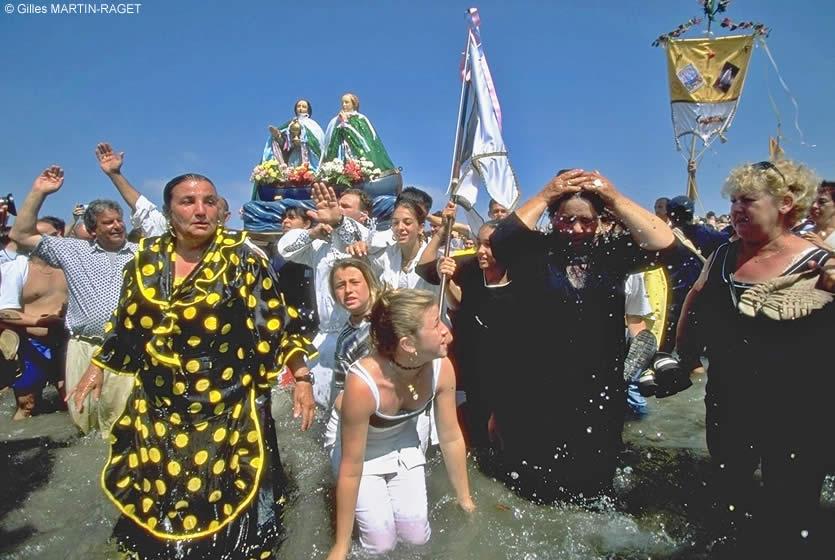
Gypsy Pilgrimage - Intense fervor
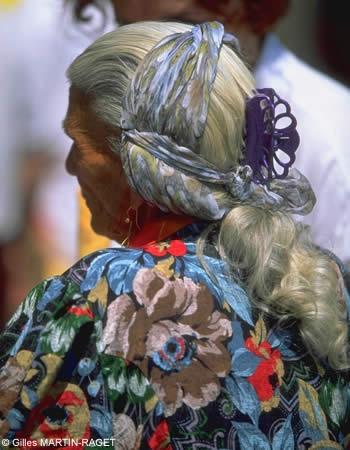
That is how, in 1965, Pope Paul VI welcomed the gypsies who had come from throughout Europe and amongst whom he wanted to celebrate his 68th birthday.
No term could suit them better. Already at the dawn of the 15th century, when their ancestors arrived in France, they presented themselves as penitents, condemned to wander the world in atonement for their sins. To back up their words, they showed letters from Pope Martin V. Throughout the Middle Ages, they remained faithful to the famous pilgrimage of Camino de Santiago.
Today more than ever, the pilgrimage, so well suited to their innate nomadism, remains the Gypsies' essential religious act. The hostile welcome that sometimes greets them in other churches, where they feel like strangers, impels them even more to get together with other travellers, to pray in their own manner and fulfill their vows. Is he or she in distress? Is a loved one sick? The Gypsy makes a wish to a saint. If it's for the Pilgrimage to Saintes Maries de la Mer, the gypsy commits him or herself to accomplishing it in the harsh conditions of penitence.
If you never see a gypsy vigil in the old fortress church lit up with candles you will never know what true gypsy fervor is. Some evenings, the crowd arrives preceded by violins and guitars. They light a multitude of small candles which everyone holds raised towards the nave. They pray loudly, they shout out invocations, they hold their children up in front of the statues... The Pilgrimage in May allows for the intensification, over several days, of the evangelization of the children and the families through chaplaincy, and conversions happen in the secrecy of their hearts. Many Gypsies also take advantage of this family gathering to have their children baptized in the church of Saintes Maries de la Mer.
Even if the time is over when the Gypsies, coming by train and sometimes on foot, spent the night in Sara's crypt, it is still for their “Patron Saint” that they come to the ancient Camargue shrine. There's no question that they also have a place in their hearts for Mary-Jacobe and Mary-Salome. The gypsies praise them as the reliquary caskets are brought down and lift their children up to let them touch and kiss the statues. But it is Sara who is "their very own saint”. Everyone adds a candle to the blazing white forest that diffuses a stifling heat in the crypt. They tuck into the box of intentions children's linens, modest pieces of jewellery, naïve messages. And then Sara is dressed anew. Forty, fifty coats are piled on the frail statue that grows bigger everyday and of which the delicate face pales with all the imploring and fervent caresses.
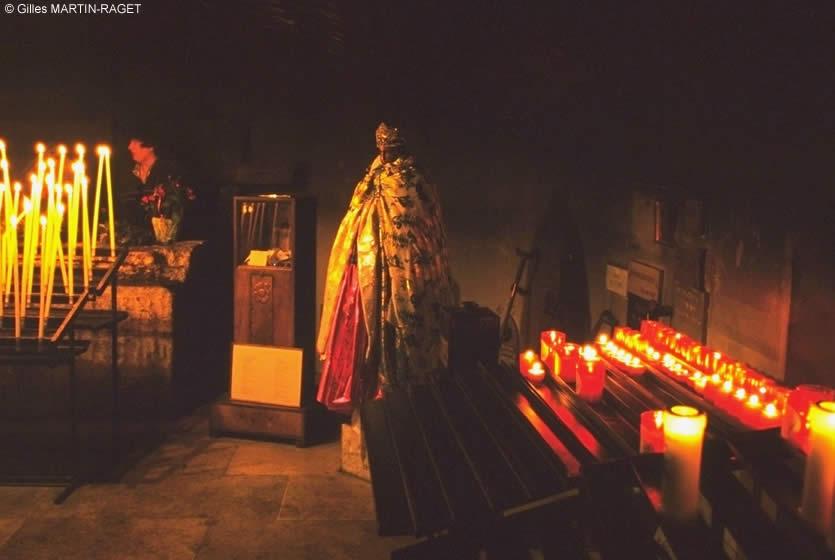
Statue of Sara - Saintes Maries de la Mer Church
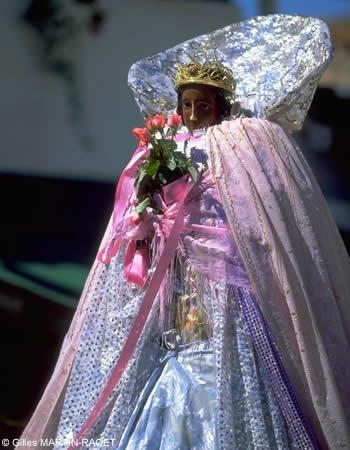
The statue of Sara, Patron Saint of the Gypsies, can be found in the Church of Saintes Maries de la Mer, at the back of the crypt to the right, wearing multicoloured dresses and jewelry. The center altar bears a reliquary, and against the wall is the Processional cross, carried by the Gypsies. You must see this crypt at the time of the May Pilgrimage, swarming with the crowd of Gypsies, illuminated by a thousand candles that the heat shapes into serpents.
Known around the world as the "Patron Saint" of the Gypsies, Sara poses for the historiographer an enigma that doesn't seem ready to be resolved. A Camargue tradition sees her as the Saints Mary Jacobe and Mary Salome's servant in Palestine, and as their companion on the banks of the Rhône. Another tradition, attributed to the Gypsies, see her as a Gypsy who was settled on the Provençal shores and who was the first to welcome, right here, the exiled women from the Holy Land. But what is the foundation for this tradition when History doesn't mention the coming of the Gypsies to France and Provence until the 15th century?
If other versions have also been put forward, in truth, no one knows who Sara was, nor how worship of her established itself in Saintes Maries de la Mer, to where people came to pray well before the French Revolution. For the Gypsies, who saw themselves in her and adopted her as their appointed protector, she is "Sara-la-Kâli", a tzigane word which means both "gitan" and "black".
The first mention of Sara can be found in a text by Vincent Philippon written around 1521: "The Legend of the Saint Marys", of which the manuscript is in the library of Arles (13). Here we see her collecting money across the Camargue to provide for the small Christian community. This practice of "soliciting" might have, think some authors, later made her likened to a Gypsy woman.
The Gypsies themselves do not ask themselves so many questions. And they follow by the thousands the amazing Procession that, on May 24, after bringing down the reliquaries, leads "their Patron" from the Church to the sea; in truth a strange troop, the people marching, a crush overflowing from the narrow streets that the Gardians on horseback have a hard time channeling, a swell of heads and faces over which rocks the frail statue carried along by the men. The Arlésiennes also give her an honouring escort, but it is still the Gypsies who, tirelessy, sing and cry out "Live Saint Sara". Folklore if you like, but still unforgettable folklore. It is too often said of Sara that she has the air of a pagan idol. That is to forget that this crowd, in its own manner, are praying. That is to not want to understand that the people, behind her, walking to the sea, are also walking towards God.
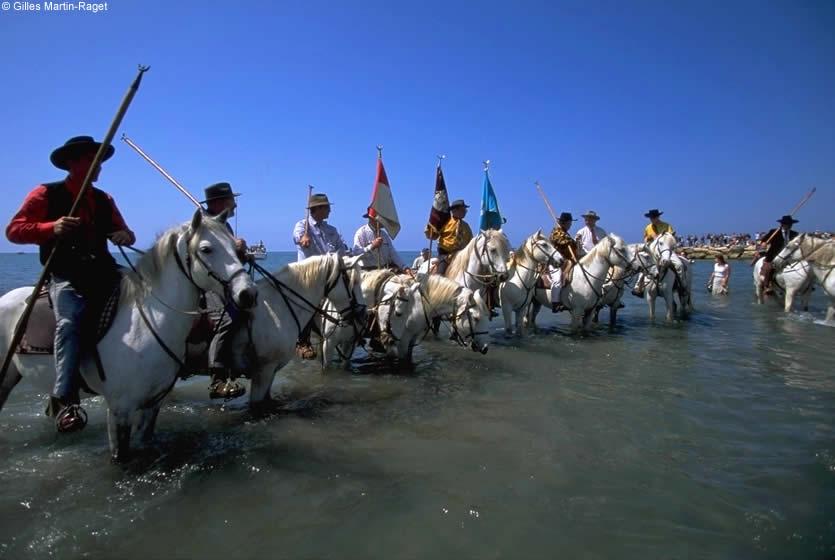
Gypsy Pilgrimage - Gardians in Camargue
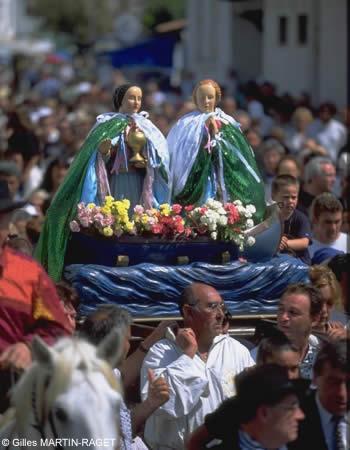
By what mystery did these two Saints find themselves on the Mediterranean shores ?
The Breviary of the Aix en Provence Diocese tells us:
"Chased by the persecution of Palestine, many of Christ's disciples were exiled and brought the Christian faith to our region."
With Mary-Magdalene, Lazarus, Maximin and many others, Mary Jacobe and Mary Salome were arrested and set off on a boat, then, near the coast, abandoned on a raft with neither sails nor paddles. Guided by Providence they reached the Provençal shore. And while the other disciples went off evangelizing far away, the Saints Mary Jacobe and Mary Salome, elderly women as they were mothers of Apostles, remained on this shore which henceforth bore their name. They would have converted the local people and the Romans who occupied the region.
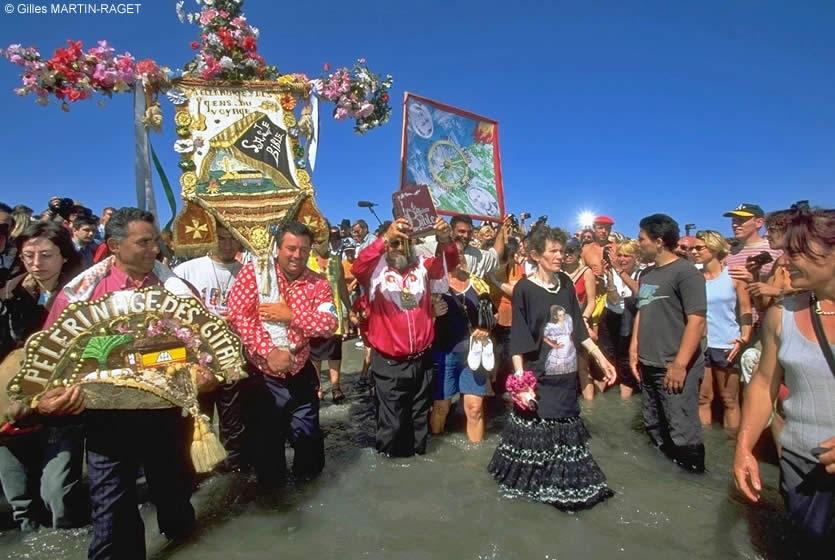
Gypsies Procession in Camargue
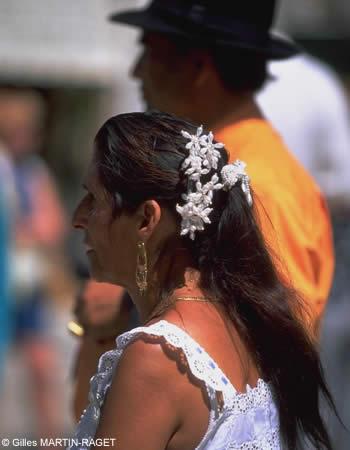
In the evening of May 25, the great festival ends. Already the caravans move off into the distance. But by what routes? For the nomads, it's that od the daily misadventure. In the whole world they do no have a single square foot they can call their own. At no time in their lives do they know what tomorrow will bring.
They may really like to be be to explain the reasons for their unconventional existence, but how? Their only certitude is that they continue to belong to a world other than our own. Neither laws, nor military service nor child benefits would change anything of this fact that reinforces the silent suspicion that surrounds them and in which we see a certain form of racism.
Who hasn't heard soomeone say "Why don't they go back where they came from?". The answer is easy: "where they came from" is here, because 95 % or our Gypsies are French citizens, many amongst them have shone on our battlefields and in the Resistance. Did you know that 300,000 of their btothers died in Nazi death camps? As to living "like everyone else", their condition prohibits it. And then, in the name of what arrogant superiority would we have it that our way of life is the only legitimate one; there are breeding pigeons and there are carrier pigeons; there are settled peoples and there are nomads and that's how it is.
So, visiting friends, you who find the Gypsies friendly when they go on long Procession or get drunk on the music and dancing in Saintes Maries de la Mer, in what light will you see them the day they arrive in your cities and towns? Will you open the door to them? Will you favour them with a smile or show some kindness to the Gypsy woman who wants to sell you her baskets, her household linens or sewing notions? Will you help them park for a good stopover somewhere other than the town dump? If you do so you will be in good company.
After a long history, the Gypsies today count many friends: in the image of Jacques Callot, who followed a group of bohemians and immortalized them in his engravings, and of Stradivarius, who learned at their school the art of violin making. In the face of the prejudice, the false stories, the scorn of so many settled people, they have woven across all of France a large network of Gypsy friends. They feel like brothers and sisters of these misunderstood people who have paid for a too long time a too heavy price for the right to continue to exist.
So let work within you the mercy of Saintes Maries de la Mer, where the poor are honoured, the rejected welcomed, the unloved comforted. Forget just the Pilgrimage or a too short visit, we would like that you become one of those for whom the arrival of the caravans is a promise of joy. That's what, in its naivity, the Rom people's beautiful prayer expresses:
Saint Sara, set us on the right path, give us you beautiful luck and give us health. et donne-nous la santé. And if someone thinks bad of us, change his heart so that he thinks good of us.
-Amen.-
Office de Tourisme Les Saintes Maries de la Mer - 5 avenue Van Gogh - BP 73 - 13732 Les Saintes Maries de la Mer
+ 33 (0)4 90 97 82 55
http://www.saintesmaries.com/